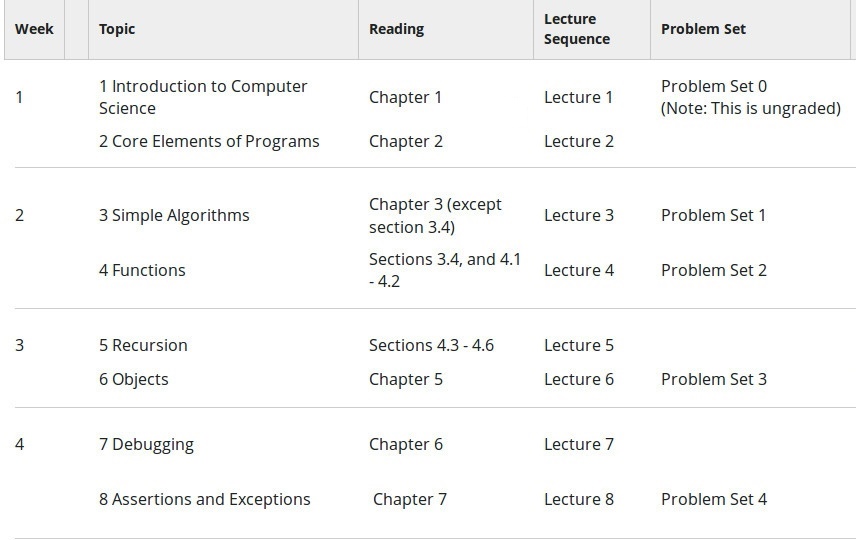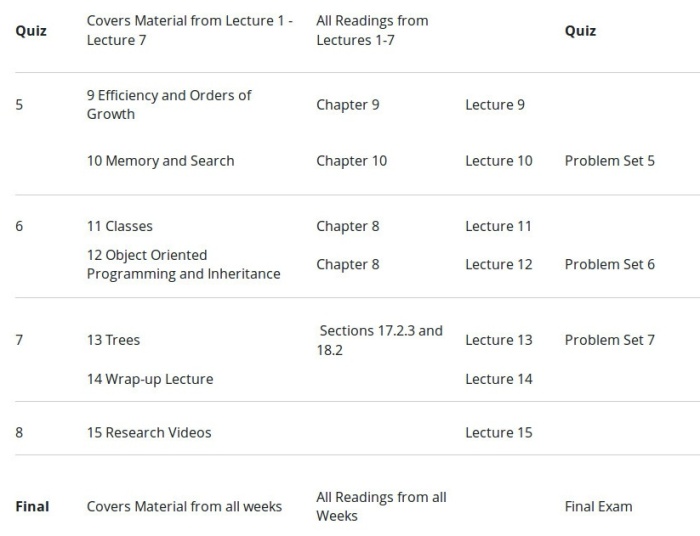I enrolled in Introduction to Computer Science and Programming Using Python with the primary objective of learning to code using Python. This course, as the name suggests, is more than just about Python. It uses Python as a tool to teach computational thinking and serves as an introduction to computer science. The fact that it is a course offered by MIT, makes it special.
As a matter of fact, this course is aimed at students with little or no prior programming experience who feel the need to understand computational approaches to problem solving. Eric Grimson is an excellent teacher (also Chancellor of MIT) and he delves into the subject matter to a surprising amount of detail.
The video lectures are based on select chapters from an excellent book by John Guttag. While the book isn’t mandatory for the course (the video lectures do a great job of explaining the material on their own), I benefited greatly from reading the textbook. There are a couple of instances where the code isn’t presented properly in the slides (typos or indentation gone wrong when pasting code to the slides), but the correct code / study material can be found in the textbook. Also, for explanations that are more in-depth, the book comes in handy.
MIT offers this course in 2 parts via edX. While 6.00.1x is is an introduction to computer science as a tool to solve real-world analytical problems, 6.00.2x is an introduction to computation in data science. For a general look and feel of the course, this OCW link may be a good starting point. It contains material including video lectures and problem sets that are closely related to 6.00.1x and 6.00.2x.
Each week’s material of 6.00.1x consists of 2 topics, followed by a Problem Set. Problem Sets account for 40% of your grade. Video lectures are followed by finger exercises that can be attempted any number of times. Finger exercises account for 10% of your grade. The Quiz (kind of like a mid-term exam) and the Final Exam account for 25% each. The course is of 8 weeks duration and covers the following topics (along with corresponding readings from John Guttag’s textbook).
From the questions posted on forums, it was apparent that the section of this course that most people found challenging, was efficiency and orders of growth – and in particular, the Big-O asymptotic notation and problems on algorithmic complexity.
Lectures on Classes, Inheritance and Object Oriented Programming (OOP) were covered really well in over 100 minutes of video time. I enjoyed the problem set that followed, requiring the student to build an Internet news filter alerting the user when it noticed a news story that matched that user’s interests.
The final week had lectures on the concept of Trees, which were done hurriedly when compared to the depth of detail the instructor had earlier gone to, while explaining concepts from previous weeks. However, this material was covered quite well in Guttag’s textbook and the code for tree search algorithms was provided for perusal as part of the courseware.
At the end of the course, there were some interesting add-on videos to tickle the curiosity of the learner on the applications of computation in diverse fields such as medicine, robotics, databases and 3D graphics.
The Wiki tab for this course (in the edX platform) is laden with useful links to complement each week of lectures. I never got around to reading those, but I’m going through them now, and they’re quite interesting. It’s a section that nerds would love to skim through.
I learnt a great deal from this course (scored well too) putting in close to 6-hours-a-week of study. It is being offered again on August 26, 2015. In the mean time, I’m keeping my eyes open for MIT’s data science course (6.00.2x) which is likely to be offered in October, in continuation to 6.00.1x.



Thanks for this review. I’m taking this course starting 26th August. How helpful is the course towards python as a web technology?
LikeLiked by 1 person
Django is a high level web framework that uses Python. This course doesn’t feature Django, since it’s more focused on CS basics using Python. Django makes it easier to build better Web apps more quickly and with less code.
LikeLiked by 1 person
Anirudh, good review of the course. I just finished it as well. One question–you mentioned Trees being covered in Guttag’s book. Which section of your book has Trees? I wonder if I have an older version of the book (2013 edition) because the only Tree-related content in my version is in section 17.2.3, where BFS and DFS are discussed.
LikeLike
Although theory on trees isn’t quite detailed in the book, the main complaint I had was that concepts covered in the video lectures were not complemented with discussions on programming. In addition to section 17.2.3, decision trees and dynamic programming is covered in chapter 18 of the book. But that too wasn’t enough. I got a lot of clarity from the script file treeSearch.py provided in the courseware.
LikeLike
[…] Currently a student of economics, and is a knowledge miner – he loves to learn.Originally published here. Took the course? Write your own review here. Read all […]
LikeLike
[…] resource. I have been taking MIT’s 6.01x introductory Python course side-by-side. I shall review that course as soon as I’m through with it. That course is pedagogically more text-bookish, and indeed […]
LikeLike
[…] had downloaded Canopy at the insistence of the instructors of MIT’s introductory course on computer science using Python. That said, I rarely ever used it. I’ve all along working on […]
LikeLike
Fantastic web site. Plenty of helpful information here.
I am sending it to several friends ans additionally sharing in delicious.
And naturally, thank you for your sweat!
LikeLike